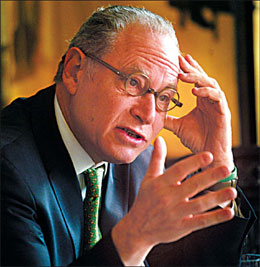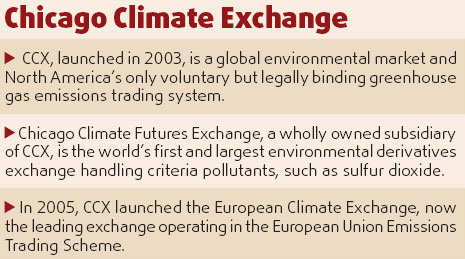Carbon warrior sets sights on new conquest
Dr Richard L Sandor's latest trip to China came at the invitation of the International Advisory Council of Guanghua School of Management at Peking University.
He is trying to spread his idea of trading pollutants in the country's most influential management school. Most businesspeople he has come across in China so far have found the idea fresh and attractive.

Sandor, internationally regarded as the "father of financial futures", was the principal architect of the development of the US Treasury futures at the Chicago Board of Trade in the 1970s.
In the 1990s, he used his financial wizardry on something new, writing on emissions trading as a solution to reducing pollution.
This pioneering work led to the Chicago Climate Exchange (CCX) in 2003, the world's first and North America's only voluntary and legally binding integrated trading system to reduce emission of greenhouse gases (GHGs), which is modeled on his work.
He was honored as one of Time Magazine's "Heroes of the Environment" for his work as the "Father of Carbon Trading" in 2007.
The CCX, which started out with 14 founding members, now has more than 200 members. There are five from China, providing offset projects to the international carbon market. But Sandor said offsets are a "very tiny" part of carbon trading.
"In China, we are at the beginning," Sandor said. "We think it is very promising. It just takes time."
Sandor is in China to discuss the CCX model for other environmental pollutants and plans to offer seminars and lectures on environmental finance at Guanghua School of Management at Peking University.
"My job is simply educating academics and young students, and finding entrepreneurs who are interested," he said.
The cap-and-trade system used by CCX is flexible. If a particular company cannot make the cuts as committed because it runs the risk of turning too costly and lengthy, while another company can make the reductions easily, the latter can sell the extra credits to the former, he said.
Such a market-based system of this sort, according to Sandor, allows companies flexibility while achieving the objective of carbon reduction.
Using such market instruments, Sandor hopes, more Chinese enterprises can join CCX to manage emissions and perhaps sell carbon credits for specialized projects. China, he thinks, can also set up a cap-and-trade system to reach the country's pollutant reduction target of cutting down emissions of SO2 and COD by 10 percent from 2006 to 2010.
At the end of last year, CCX and Chinese National Petroleum Corporation Assets Management Co Ltd signed a memorandum of understanding to create a joint venture company to explore the feasibility and implementation of an emissions trading platform in China for various pollutants.

"I think the Chinese miracle (of development) is fantastic," he said. "But I think that if the miracle is to continue, environment problems must be addressed cost-effectively. My personal dream is to play a part and help China learn how to do this."
But he admitted that setting up a trading system can be hard. There have to be lots of different institutions to serve the market. "It is not just a matter of know-how. Trading is a complex system."
Sandor has been in China visiting key research, policy and trading enterprises.
"The system has to include banking, trading, verifying, monitoring and product designing," he said. "Also, it has to fit China's special characteristics in economic development and culture.
"Confucius had a famous proverb - a journey of a thousand mile begins with one step. With our Chinese colleagues, we hope to make that first step here in China."
(China Daily 01/22/2008 page15)








